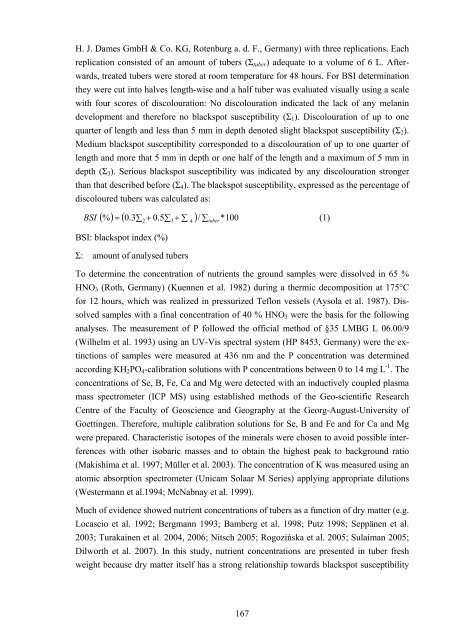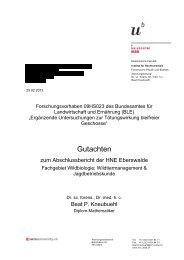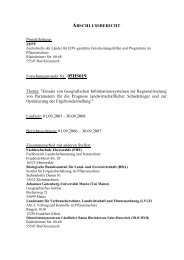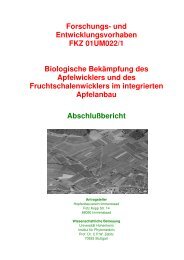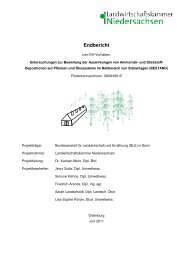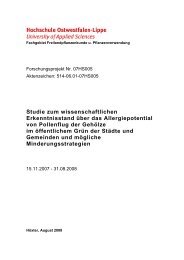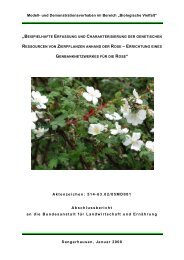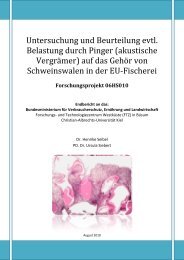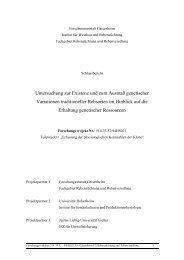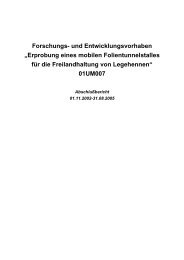Abschlussbericht Projekt: „Verminderung der ... - BLE
Abschlussbericht Projekt: „Verminderung der ... - BLE
Abschlussbericht Projekt: „Verminderung der ... - BLE
Erfolgreiche ePaper selbst erstellen
Machen Sie aus Ihren PDF Publikationen ein blätterbares Flipbook mit unserer einzigartigen Google optimierten e-Paper Software.
H. J. Dames GmbH & Co. KG, Rotenburg a. d. F., Germany) with three replications. Each<br />
replication consisted of an amount of tubers (Σ tuber ) adequate to a volume of 6 L. Afterwards,<br />
treated tubers were stored at room temperature for 48 hours. For BSI determination<br />
they were cut into halves length-wise and a half tuber was evaluated visually using a scale<br />
with four scores of discolouration: No discolouration indicated the lack of any melanin<br />
development and therefore no blackspot susceptibility (Σ 1 ). Discolouration of up to one<br />
quarter of length and less than 5 mm in depth denoted slight blackspot susceptibility (Σ 2 ).<br />
Medium blackspot susceptibility corresponded to a discolouration of up to one quarter of<br />
length and more that 5 mm in depth or one half of the length and a maximum of 5 mm in<br />
depth (Σ 3 ). Serious blackspot susceptibility was indicated by any discolouration stronger<br />
than that described before (Σ 4 ). The blackspot susceptibility, expressed as the percentage of<br />
discoloured tubers was calculated as:<br />
( ) ( 0.3∑ + 0.5∑ + ∑ )/<br />
∑<br />
BSI % 2 3 4<br />
* 100<br />
(1)<br />
= tuber<br />
BSI: blackspot index (%)<br />
Σ: amount of analysed tubers<br />
To determine the concentration of nutrients the ground samples were dissolved in 65 %<br />
HNO 3 (Roth, Germany) (Kuennen et al. 1982) during a thermic decomposition at 175°C<br />
for 12 hours, which was realized in pressurized Teflon vessels (Aysola et al. 1987). Dissolved<br />
samples with a final concentration of 40 % HNO 3 were the basis for the following<br />
analyses. The measurement of P followed the official method of §35 LMBG L 06.00/9<br />
(Wilhelm et al. 1993) using an UV-Vis spectral system (HP 8453, Germany) were the extinctions<br />
of samples were measured at 436 nm and the P concentration was determined<br />
according KH 2 PO 4 -calibration solutions with P concentrations between 0 to 14 mg L -1 . The<br />
concentrations of Se, B, Fe, Ca and Mg were detected with an inductively coupled plasma<br />
mass spectrometer (ICP MS) using established methods of the Geo-scientific Research<br />
Centre of the Faculty of Geoscience and Geography at the Georg-August-University of<br />
Goettingen. Therefore, multiple calibration solutions for Se, B and Fe and for Ca and Mg<br />
were prepared. Characteristic isotopes of the minerals were chosen to avoid possible interferences<br />
with other isobaric masses and to obtain the highest peak to background ratio<br />
(Makishima et al. 1997; Müller et al. 2003). The concentration of K was measured using an<br />
atomic absorption spectrometer (Unicam Solaar M Series) applying appropriate dilutions<br />
(Westermann et al.1994; McNabnay et al. 1999).<br />
Much of evidence showed nutrient concentrations of tubers as a function of dry matter (e.g.<br />
Locascio et al. 1992; Bergmann 1993; Bamberg et al. 1998; Putz 1998; Seppänen et al.<br />
2003; Turakainen et al. 2004, 2006; Nitsch 2005; Rogozińska et al. 2005; Sulaiman 2005;<br />
Dilworth et al. 2007). In this study, nutrient concentrations are presented in tuber fresh<br />
weight because dry matter itself has a strong relationship towards blackspot susceptibility<br />
167


